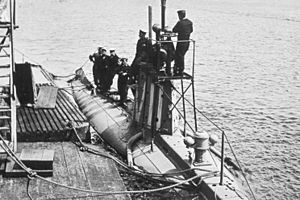HMS A7 facts for kids
class="infobox " style="float: right; clear: right; width: 315px; border-spacing: 2px; text-align: left; font-size: 90%;"
| colspan="2" style="text-align: center; font-size: 90%; line-height: 1.5em;" | 
|}
HMS A7 was an early submarine built for the Royal Navy in the United Kingdom. She was part of the first group of submarines designed for the British navy. Sadly, she sank during a training exercise in 1914, and all her crew members were lost. Today, her wreck is a protected site, meaning it's illegal to dive on it without special permission from the Ministry of Defence.
Contents
| History | |
|---|---|
| Name | HMS A7 |
| Builder | Vickers Barrow-in-Furness |
| Laid down | 19 February 1903 |
| Launched | 23 January 1905 |
| Commissioned | 16 January 1905 |
| Fate | Sunk in Whitsand Bay, 16 January 1914 |
| General characteristics | |
| Class and type | A-class submarine |
| Displacement |
|
| Length | 105 ft (32.0 m) |
| Beam | 12 ft 9 in (3.9 m) |
| Draught | 10 ft 8 in (3.3 m) |
| Installed power |
|
| Propulsion |
|
| Speed |
|
| Range | 500 nautical miles (930 km; 580 mi) at 10 kn (19 km/h; 12 mph) surfaced |
| Complement | 2 officers and 9 ratings |
| Armament | 2 × 18-inch (45 cm) torpedo tubes |
What Was HMS A7?
HMS A7 was one of the very first submarines built for the British Royal Navy. She was part of the A-class submarines, which were the first of their kind for Britain. A7 was a bit bigger and faster than the first ship in her class, HMS A1.
How Was A7 Designed?
The submarine was about 105 ft (32.0 m) long, which is roughly the length of three school buses. She was 12 feet 9 inches (3.9 m) wide. When floating on the surface, she weighed about 190 long tons (193 t). When she was underwater, she weighed a bit more, around 206 long tons (209 t). The A-class submarines usually had a crew of 2 officers and 11 other sailors.
Power and Speed
When A7 was on the surface, she used a powerful 550-brake-horsepower (410 kW) petrol engine. This engine turned a single propeller shaft to move the submarine through the water. When she went underwater, a 150-horsepower (112 kW) electric motor took over.
On the surface, A7 could travel at a speed of 11 knots (20 km/h; 13 mph) (knots). Underwater, she was slower, reaching about 7 knots (13 km/h; 8.1 mph). She could travel about 500 nautical miles (930 km; 580 mi) (nautical miles) on the surface at a speed of 10 knots (19 km/h; 12 mph).
Weapons
The submarines of this class were armed with two torpedo tubes at the front. These tubes could fire torpedoes, which are underwater missiles. They could carry two extra torpedoes, but often didn't. Carrying extra torpedoes meant they had to carry less fuel to balance the weight.
Building and Service
A7 was ordered in 1903 and built by a company called Vickers in Barrow-in-Furness. Her construction started on 1 September 1903. She was launched into the water on 21 January 1905 and finished being built on 13 April of the same year.
The Tragic Accident
On 16 January 1914, A7 was taking part in a training exercise in Whitsand Bay, Cornwall. She was practicing dummy torpedo attacks with another ship, HMS Pygmy, and another submarine, HMS A9.
During the exercise, people saw a disturbance in the water. They thought it might have been the crew of A7 trying to push water out of her ballast tanks. This is a way submarines try to quickly rise to the surface.
HMS Pygmy marked the spot with a buoy and went back to Plymouth Sound to report what happened. When Pygmy returned later, the weather had gotten worse, and they couldn't find the buoy.
Attempts to Save Her
It took five days to find A7 again. She was found in water about 121 ft (37 m) deep. Her back end (stern) was buried about 20 ft (6.1 m) deep in the muddy seabed. Her front end (bow) was sticking up about 33 ft (10 m) from the bottom, at a 30-degree angle.
Over the next month, several attempts were made to salvage (rescue) her. Workers tried to attach strong ropes to her bow or wrap steel ropes around her hull. However, her stern was stuck too deep in the mud. The ropes kept breaking without pulling her out.
A Protected Wreck Today
A7 still lies where she sank. She is buried up to her waterline in the mud, in about 121 ft (37 m) of water. In 2001, the British Government declared her a "Controlled Site." This means she is one of 16 shipwrecks in British waters protected under the Protection of Military Remains Act 1986. You cannot dive on her without special permission.
In 2014, a team called the SHIPS Project in Plymouth did an archaeological study of the A7 submarine. They were given a special licence by the UK Ministry of Defence to do this work.

